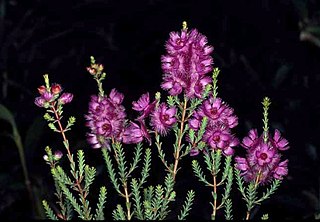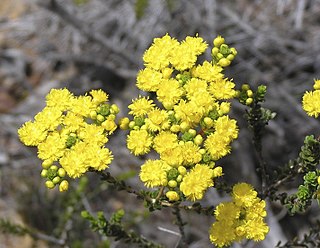Verticordia brachypoda is a flowering plant in the myrtle family, Myrtaceae and is endemic to the south-west of Western Australia. It is an irregularly branched shrub with narrow leaves crowded on side-branches, and cream-coloured or white flowers with pink, cream or white centres.

Verticordia verticillata, commonly known as tropical featherflower or whorled-leaved featherflower is a flowering plant in the myrtle family, Myrtaceae and is endemic to an area in the north of the Northern Territory and Western Australia. It is a woody shrub or small tree with relatively long, linear leaves arranged in whorls, and with irregular groups of creamy-white flowers in spring.
Verticordia sect. Verticordia is one of eleven sections in the subgenus Verticordia. It includes eight species of plants in the genus Verticordia. Plants in this section are open to bushy shrubs up to 1 m (3 ft) tall with needle-like leaves, feather-like sepals and anthers opening by slanting pores. When Johannes Conrad Schauer described other subgenera in Verticordia, subgenus Verticordia became an autonym after Augustin de Candolle who described the genus in 1828. When Alex George reviewed the genus in 1991, he took the name of this section from that of the subgenus.
Verticordia sect. Chrysoma is one of seven sections in the subgenus Chrysoma. It includes four species of plants in the genus Verticordia. Plants in this section are small shrubs with small, bright yellow flowers which usually turn red as they age. They have sepals with fringed lobes and petals which have lobes arranged like the fingers of a hand. The subgenus Chrysoma was originally described in 1843 by Johannes Conrad Schauer and the description was published in Monographia Myrtacearum Xerocarpicarum. When Alex George reviewed the genus in 1991, he took the name of this section from that of the subgenus.

Verticordia is a genus of more than 100 species of plants commonly known as featherflowers, in the myrtle family, Myrtaceae. They range in form from very small shrubs such as V. verticordina to trees like V. cunninghamii, some spindly, others dense and bushy, but the majority are woody shrubs up to 2.0 m (7 ft) tall. The flowers are variously described as "feathery", "woolly" or "hairy" and are found in most colours except blue. They often appear to be in rounded groups or spikes but in fact are always single, each flower borne on a separate stalk in a leaf axil. Each flower has five sepals and five petals all of a similar size with the sepals often having feathery or hairy lobes. There are usually ten stamens alternating with variously shaped staminodes. The style is simple, usually not extending beyond the petals and often has hairs near the tip. All but two species are found in Southwest Australia, the other two occurring in the Northern Territory.

Verticordia decussata is a flowering plant in the myrtle family, Myrtaceae and is endemic to an area in the north of the Northern Territory. It is an open shrub with a distinctive leaves and leaf arrangement and small spikes of cream to white flowers on the ends of the branches.

Homoranthus flavescens is a plant in the myrtle family Myrtaceae and is endemic to northern New South Wales. It is a low, spreading, flat-topped shrub with cylinder-shaped or flattened leaves. Single yellow to reddish flowers appear in leaf axils in late spring and summer, forming clusters near the end of the branchlets.

Verticordia drummondii, commonly known as Drummond's featherflower, is a flowering plant in the myrtle family, Myrtaceae and is endemic to the south-west of Western Australia. It is an erect, openly to densely branched shrub with small, narrow leaves and pink to purple flowers in small heads near the ends of the branches.
Verticordia endlicheriana var. compacta is a flowering plant in the myrtle family, Myrtaceae and is endemic to the south-west of Western Australia. It is a small, usually compact shrub with sweetly-perfumed, golden-yellow flowers which fade through reddish to almost black as they age.
Verticordia huegelii var. stylosa, commonly known as variegated featherflower, is a flowering plant in the myrtle family, Myrtaceae and is endemic to the south-west of Western Australia. It is a single-stemmed shrub with its growth form depending on its surroundings. It is similar to other varieties of the species but differs in its flower colour and the form of the style and staminodes.

Verticordia lindleyi is a flowering plant in the myrtle family, Myrtaceae and is endemic to the south-west of Western Australia. It is sometimes an openly branched shrub, other times more or less dense, with small leaves and spreading, spike-like groups of pink or purple flowers along the stems in summer, sometimes also in autumn.

Verticordia serrata is a flowering plant in the myrtle family, Myrtaceae and is endemic to the south-west of Western Australia. It is a spindly or openly branched shrub with hairy, egg-shaped leaves and flowers which are golden at first, then fade to a greyish colour.
Verticordia sieberi is a flowering plant in the myrtle family, Myrtaceae and is endemic to the south-west of Western Australia. It is a shrub with one main stem, often compact but sometimes openly branched and with pink to pale purple flowers in summer and autumn.
Verticordia sect. Catocalypta is one of eleven sections in the subgenus Verticordia. It includes seven species of plants in the genus Verticordia. Plants in this section are small, bushy shrubs which grow to a height of up to 1 m (3 ft), have thick, fleshy, leaves which are triangular in cross-section. The flowers are arranged in open, corymb-like heads of relatively large flowers. Importantly, their sepals have down-turned, tufts of hair which surround the floral cup.

Calytrix angulata, commonly known as yellow starflower, is a species of plant in the myrtle family Myrtaceae that is endemic to Western Australia.
Calytrix brownii, commonly known as the white turkeybush, is a species of plant in the myrtle family Myrtaceae that is endemic to Western Australia.
Calytrix decandra, commonly known as the pink starflower, is a species of plant in the myrtle family Myrtaceae that is endemic to Western Australia.

Calytrix glutinosa is a species of plant in the myrtle family Myrtaceae that is endemic to Western Australia.

Calytrix sapphirina is a species of plant in the myrtle family Myrtaceae that is endemic to Western Australia.

Homoranthus virgatus is a flowering plant in the family Myrtaceae and is endemic to coastal areas of northern New South Wales. It is an upright shrub with wand-like branches.











